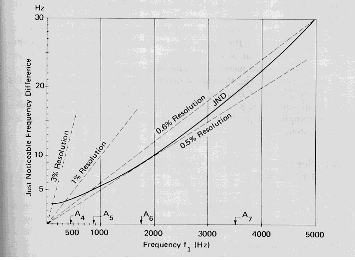
Introduction To The Psychophysics of Hearing[*]
JND - Just Noticeable Difference
There is a natural limit to an individuals ability to establish a relative order of pitch when two pure tones (sine tones) of the same intensity are presented one after another. When the difference in frequency between the two tones is too small, both tones are judged as having the same pitch. This is true for order judgments for all psychophysical magnitudes: whenever the variation of an original physical stimulus lies within a certain difference limen or just noticeable difference (JND) the associated sensation is judged as remaining the same. As soon as the variation exceeds the JND, a change in sensation is detected.
Frequency and Pitch
The degree of sensitivity of the primary pitch mechanism to frequency changes (frequency
resolution capability) depends on the frequency, intensity, and duration
of the tone in question. It varies greatly from person to person, is affected by
musical training, and depends considerably on the method of measurement employed.

Figure 2.9 shows the average JND in frequency for pure tones of constant intensity (80 dB) whose frequency was slowly and continuously modulated up and down. The graph shows, for example that for a tone of 2 KHz a change of 10 Hz (ie only 0.5%) can already be detected. This is a very small fraction of a semitone!. Sudden changes are detected with a considerably lower JND (up to 30 times smaller than the values shown).
The JND in frequency is not defined sharply. There are two critical thresholds:
1 A frequency increment below which a change in pitch is never detected, sometimes called the neural quantum of pitch detection; and
2 a frequency increment above which a change in pitch is always detected, the value of which is approximately twice that of the neural quantum.
NEXT INDEX Previous topic: PHYSIOLOGY OF HEARING